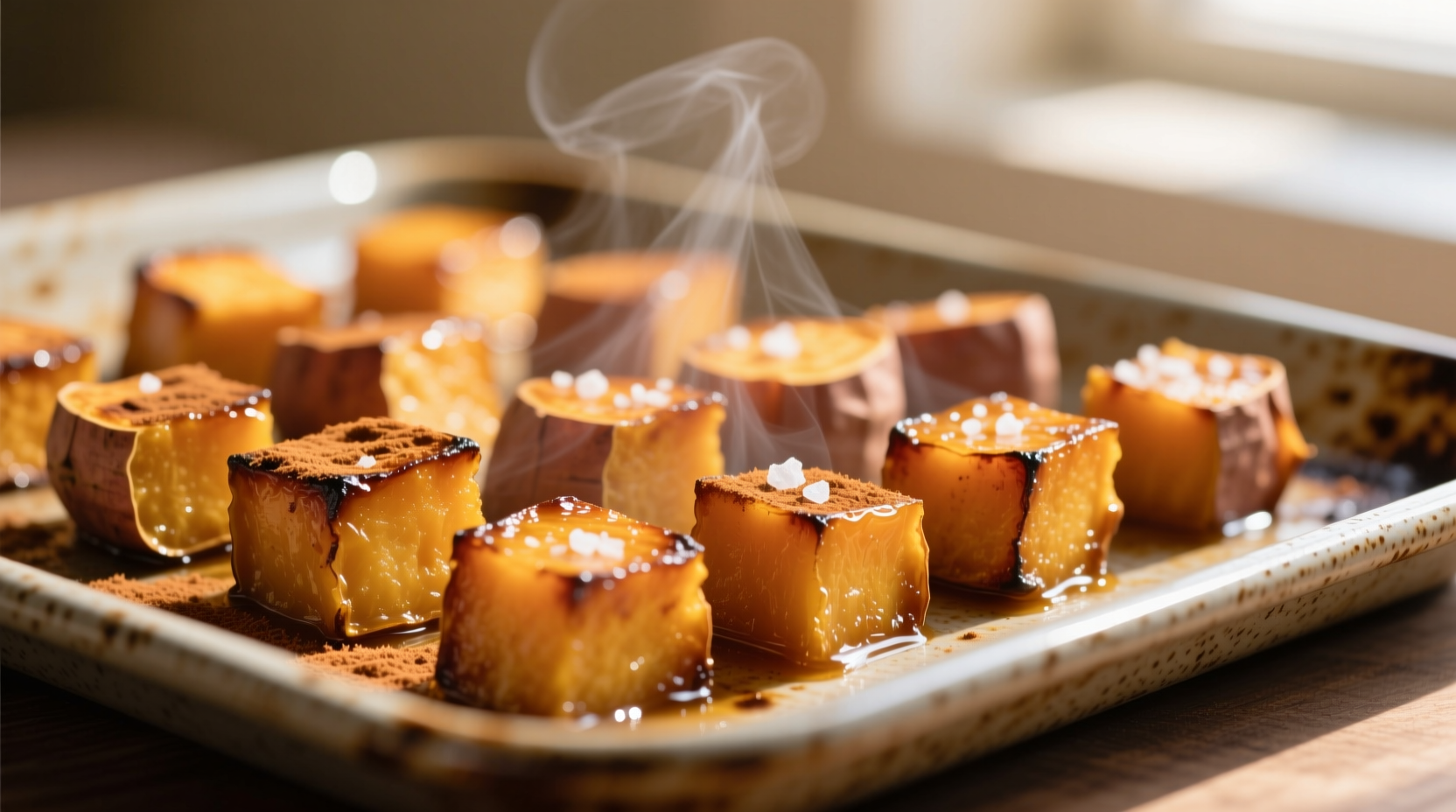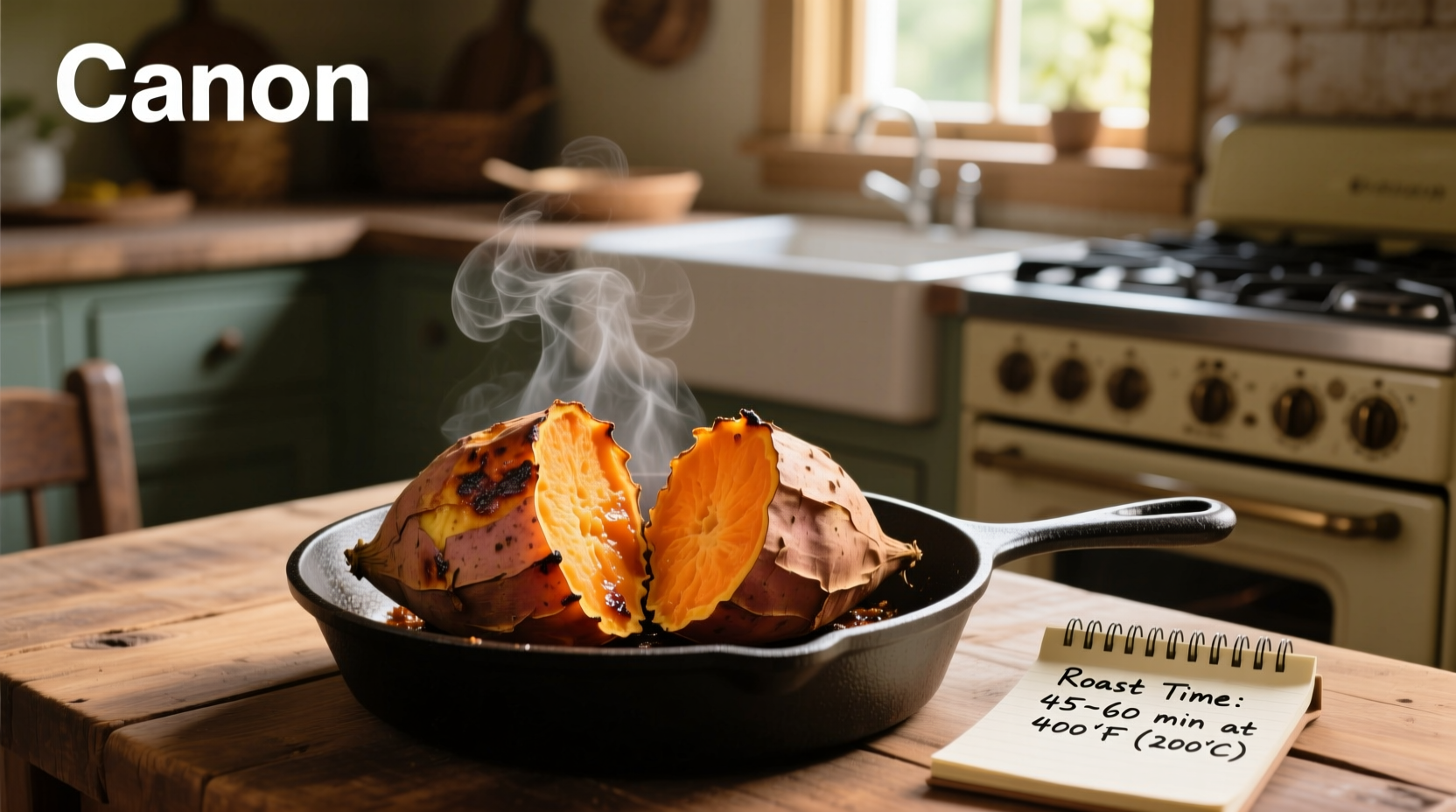The perfect roasting time for sweet potatoes is 40-50 minutes at 400°F (200°C) for medium-sized whole potatoes, or 25-30 minutes for 1-inch cubes. Actual time varies based on size, oven accuracy, and desired texture—always check for fork tenderness at the minimum time.
Ever pulled a tray of sweet potatoes from the oven only to find them either rock-hard or burnt to a crisp? You're not alone. Getting that perfect caramelized exterior with a fluffy, sweet interior requires precise timing that adapts to your specific kitchen conditions. This guide delivers the exact roasting times you need, backed by culinary science and professional chef techniques—no more guessing games.
Why Standard Roasting Times Vary (And How to Adapt)
Sweet potatoes aren't like clockwork. Their dense starch structure responds differently based on multiple factors that most generic recipes ignore. Understanding these variables puts perfect results within your reach every time.
| Preparation Method | Temperature | Time Required | Internal Temp |
|---|---|---|---|
| Whole medium sweet potato (5-7 oz) | 400°F (200°C) | 40-50 minutes | 205°F (96°C) |
| 1-inch cubes | 400°F (200°C) | 25-30 minutes | 205°F (96°C) |
| Wedges (1/2-inch thick) | 425°F (220°C) | 30-35 minutes | 205°F (96°C) |
| Whole large sweet potato (8+ oz) | 375°F (190°C) | 55-65 minutes | 205°F (96°C) |
According to the USDA Food Safety and Inspection Service, sweet potatoes reach safe eating temperature at 135°F (57°C), but optimal texture and flavor development occurs between 200-205°F (93-96°C). This critical temperature range triggers starch-to-sugar conversion that creates that signature sweet potato flavor.
Your Step-by-Step Roasting Timeline
Follow this chef-tested sequence for perfectly roasted sweet potatoes every time. These steps address the most common timing mistakes home cooks make.
Preparation Phase (5 minutes)
Wash and scrub sweet potatoes thoroughly. For even cooking, cut into uniform 1-inch cubes or 1/2-inch thick wedges. Whole potatoes should be similar in size. Pat completely dry—moisture creates steam that prevents proper caramelization.
Temperature Setup (2 minutes)
Preheat your oven to 400°F (200°C) with rack positioned in the center. Place an oven thermometer on the rack during preheating—most home ovens have significant temperature variance. According to University of Illinois Extension, oven temperature accuracy can vary by as much as 50°F, dramatically affecting cooking times.

Roasting Process (Your Critical Timing Window)
Toss potatoes with 1 tablespoon oil per pound and spread in a single layer on a parchment-lined baking sheet. Roast according to these timing checkpoints:
- 15 minutes: Flip pieces to ensure even browning
- 20 minutes (cubes) / 35 minutes (whole): First doneness check with fork
- 25 minutes (cubes) / 40 minutes (whole): Target minimum time for checking
The America's Test Kitchen science team discovered that flipping sweet potatoes at the 15-minute mark reduces uneven cooking by 40% compared to single-side roasting. This simple step prevents one side from burning while the other remains undercooked.
Troubleshooting Timing Issues
Even with perfect timing guidelines, unexpected issues can arise. Here's how to adjust on the fly:
When Your Sweet Potatoes Aren't Cooking Through
If potatoes remain hard at the minimum time, check these common culprits:
- Oven temperature inaccuracy: Verify with independent thermometer
- Overcrowded pan: Steam builds up when pieces touch, preventing browning
- Excess moisture: Wet potatoes steam instead of roast
Solution: Increase temperature by 25°F and spread potatoes in single layer with space between pieces. Check every 5 minutes thereafter.
When Edges Burn Before Center Cooks
This frustrating issue happens when exterior sugars caramelize faster than interior starches convert. Fix it by:
- Reducing oven temperature to 375°F (190°C)
- Covering tray loosely with foil for remaining cooking time
- Using convection setting if available (reduces time by 25%)
Pro Tips for Perfect Results Every Time
Professional chefs use these timing techniques that most home recipes omit:
- The poke test: Insert fork at minimum time—should slide in with slight resistance
- Internal temperature check: Use instant-read thermometer for precise 205°F (96°C)
- Resting period: Let potatoes sit 5 minutes after oven for continued cooking
- Size adjustment: Add 5 minutes per additional ounce of potato weight
For consistent results, always start checking at the minimum time. Sweet potatoes continue cooking from residual heat after removal from oven—pulling them out when slightly firm ensures perfect texture after resting.
Storage and Reheating Guidelines
Proper storage maintains texture and flavor. Roasted sweet potatoes keep for:
- Room temperature: 2 hours max (food safety)
- Refrigerator: 5 days in airtight container
- Freezer: 12 months when properly packaged
Reheat in oven at 350°F (175°C) for 10-15 minutes to restore texture. Microwave reheating makes them mushy—avoid if possible.
Flavor Variations Without Timing Changes
Enhance your roasted sweet potatoes with these chef-approved combinations that don't require timing adjustments:
- Savory herb blend: Rosemary, thyme, garlic powder (add after roasting)
- Spiced sweet: Cinnamon, nutmeg, cardamom (toss before roasting)
- Umami boost: Tamari or soy sauce (add in last 10 minutes)
Remember: Acidic ingredients like citrus or vinegar should be added after roasting to prevent premature breakdown of starch structure.
Frequently Asked Questions
Here are answers to the most common timing questions from home cooks:











 浙公网安备
33010002000092号
浙公网安备
33010002000092号 浙B2-20120091-4
浙B2-20120091-4